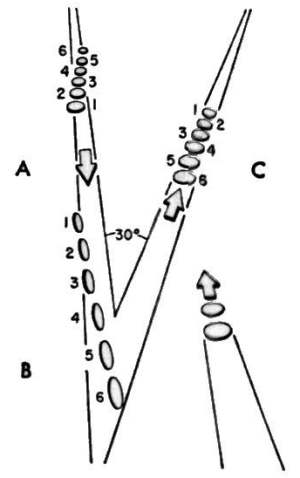The following is a reprint from Bio-Science, volume 17, No. 1, 1967, pages 15-24. This extract was submitted by Dr. Frank B. Salisbury, head, plant science department, Utah State University, as summarizing his views on UFOs, to the UFO congressional hearings in the US in 1967.
2. The Chesapeake Bay Case, July 14, 1952.
This is one of the best documented sightings on record, involving extremely high speeds and a sharp change of direction (Fig. 3). First Officer William B. Nash and 2nd Officer William H. Fortenberry were flying a commercial plane from New York to Miami, approaching Newport News, Virginia. At 8:12 (just after dark) a brilliant red glow suddenly appeared in the west. It was soon resolved as six coin-shaped objects flying in line formation. They glowed with a brilliant orange-red color on top, were estimated to be 100 feet in diameter and 15 feet thick. They moved rapidly toward the plane, at one point breaking slightly in their perfect formation as the second and third objects wavered slightly and almost overran the leader. They turned in unison on edge and reversed position in the formation, the last object moving up to the front position with the others following. They then abruptly reversed direction, moving off somewhat to the right with the original leader again in the lead position. The turn was executed almost like balls bouncing off a wall with no wavering or arc apparent. Two other objects raced out from beneath the plane and took up positions seven and eight in the formation. They decreased in brilliance just before making the turn; objects seven and eight were by far the brightest as they approached the formation; and for a brief interval or two all eight blinked out and then came back on again. They sped off, climbing to an altitude above that of the airplane, and then one by one but at random their lights blinked off and the sighting was finished. In repeating mentally their observation, the pilots estimated that it had lasted only about 12 to 15 seconds.

Fig. 3. Reported Actions of Chesapeake Bay Discs.
Menzel and Boyd (1963), after considering many possible explanations for the sighting, concluded that the pilots must have seen the illuminated discs produced by a red searchlight shining through nearly transparent thin layers of haze. Charles Maney (1965) corresponded with Menzel for several months, considering all of the possible explanations that might come to mind. Apparently Menzel would have readily accepted several explanations if Maney had not one by one clearly demonstrated their implausibility. The pilots themselves thoroughly rejected Menzel's searchlight hypothesis, saying that they were familiar with such phenomena, and this was simply not what they observed. The details described above are certainly difficult to reconcile with a searchlight hypothesis. The extremely short duration of the sighting, however, makes one question the absolute accuracy of the account. Did some points develop a bit with discussion and remembering? Furthermore, the velocities of the UFO's calculated at Between 6,000 and 12,000 mph through a dense atmosphere at 2,000 feet and including an instantaneous reversal in direction, are, to say the least, extremely difficult to fit into our present concepts of the universe. Light images could perform these maneuvers, but how could they perform some of the other maneuvers reported by the two pilots?
This case is presented as an example of the problems met by a UFO researcher. To solve a sighting such as this to everyone's satisfaction would require turning the clock back.
The case discussed here was conceeded to have no conventionnal explanation by project Blue Book, USAF's study of UFO reports. More information here.